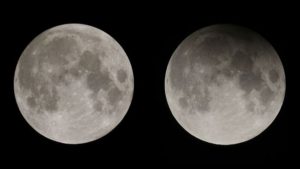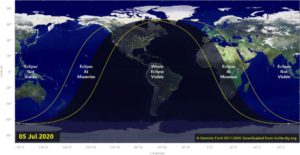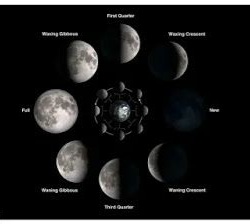On 5th July, the Penumbral Lunar Eclipse will take place. However, for Indians, this eclipse might not be visible as it will be taking place in the day time. Thus, it will be hard for Indians to witness the event.
However, do keep in mind that this is actually a hidden eclipse.
How?
Read this article to find all you need to know about the Penumbral lunar eclipse.
So while the others would be more than eager to tell you the following details –
1. First, the lunar eclipse of July 5 will begin at 8:37 AM IST and will end at 11:22 AM IST and this eclipse will reach its peak at 9:59 AM IST.
2. Secondly, the live streaming of the penumbral lunar eclipse is available on various YouTube channels and websites.
3. Lastly, to view the eclipse, no special equipment is needed. One can witness the phenomenon easily with naked eyes.
That’s true and untrue. The timing is correct, but the visibility is not.
Now, let us tell you the truth about Penumbral Lunar Eclipse.
To define literally, according to the Oxford Dictionary, an eclipse is:-
“A concealment of the light from one celestial body, in this case, the Moon, by the passage of another, which is the Earth in this case, between it and the viewer, or between it and its light- source, that is the Sun.”
In other words, what happens in an eclipse is that the moon is eclipsed by the shade of the Earth.
In a normal year, lunar eclipses can take place about two to five times. Science identifies three kinds of lunar eclipses: Total, Partial, and Penumbral.
Now, what is a penumbral lunar eclipse?
If we are being precise, during the eclipse, the Earth radiates not one but two shadows out into space.
Out of both, the most obvious one is a murky, slender, dwindling cone of darkness that extends out into space for some 857,000 miles (1.38 million kilometers), which is called the umbra.
During the time of a general eclipse of the moon, the inner part of Earth’s shadow, also called the umbra, falls on the moon’s face. In the middle of the eclipse, the moon may appear blood red as the entire moon is covered in shadow.
So what happens is that during a lunar eclipse, wherever the umbra falls upon the moon’s surface, one would see the Earth completely cover that part, and hence that part would be plunged into darkness.
If seen from here on the Earth, one would see the umbra, what is projected as a curved zone of darkness, dramatically cutting into the moon’s face.
And to the ancients, it appeared as if some invisible monster was “biting” into the moon. That’s why they called it a divine event.
It is simply the half-shadow that lies outside every deep shadow, whether it is cast by the Earth or a building.
If someone, imagine a hypothetical astronaut, is positioned just outside of the edge of the umbra, they would be very deep into the penumbra.
And looking up from the lunar surface they would see the Earth covering all but a narrow sliver of the sun in the lunar sky.
Read also – https://theqna.org/we-may-live-in-a-space-opera-universe/
And while looking in all directions, the illumination of the lunar landscape would appear noticeably subdued.

So, it does not cause complete darkness like on a full eclipse, but still, the overall lighting coming from that lingering sliver of sunshine would be significantly paler than usual.
And when inspected from here on the Earth, one wouldn’t see a sharp curve of darkness, rather they would see that a part of the moon looks somewhat “tarnished” or “smudged.”
That’s usually all that is noticed during most penumbral lunar eclipses — just a very subtle shading.
But, even that won’t be seen by naked eyes.
According to reports, on Saturday night, the moon will skim partially through the southern part of the penumbra which means that the upper part of the moon will be inside the penumbral shadow.

However, as the geometric magnitude of this eclipse is listed as 0.3546, so about one-third of the moon’s diameter will be inside of the so-called “half-shadow”, or the penumbra, at the time of the maximum eclipse.

So, the lower two-thirds of the moon would be totally outside of the penumbral shadow. And about the upper-third?
Would one be able to notice any darkening there?
The answer is again “no.” If, as imagined above, the astronaut was placed on the lunar surface in the region north of Mare Frigoris, also called the “Sea of Cold”, they would have seen the Earth covering about one-third of the sun.
But that still would not have any noticeable effect on the darkening of the lunar landscape. And so, everything would look pretty much the same as it would without any of the sun being covered.
And if seen from Earth at that moment, that is at 9:30 p.m. PDT or 12:30 a.m. EDT on Sunday (04:30 July 5 GMT), at the moon one would very likely see nothing.
Yes, the charts and calendars are correct. The moon is officially full and would be undergoing an eclipse. It is just that the moon’s path on Saturday will take it through an extremely weak part of the penumbra.
And so, the moon will retain its normal guise.
This, during the penumbral lunar eclipse, only very observant people might notice a dark tint on the moon’s face. Others could look at the moon and might see nothing unusual.
From where to see it
The Countries from where one could observe the phenomenon clearly are South/West Europe, parts of Africa, parts of North America, South America, Pacific, Atlantic, Indian Ocean, and Antarctica.
Furthermore, parallel to the last two lunar eclipses this one will also be a penumbral lunar eclipse. In fact, all lunar eclipses this year will be penumbral. The next lunar eclipse will be taking place between November 29 to November 30
1 thought on “Penumbral Lunar Eclipse 2020 :- Beautiful, Won’t You Agree ?”